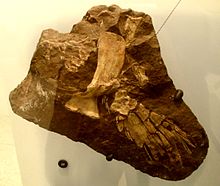Rhizodontidae
| Rhizodontidae | ||||||||||||
|---|---|---|---|---|---|---|---|---|---|---|---|---|

Speculative life reconstruction of Rhizodus |
||||||||||||
| Temporal occurrence | ||||||||||||
| Middle Devon to Pennsylvania | ||||||||||||
| 365 to 298.9 million years | ||||||||||||
| Locations | ||||||||||||
| Systematics | ||||||||||||
|
||||||||||||
| Scientific name of the order | ||||||||||||
| Rhizodontiformes | ||||||||||||
| Andrews & Westoll , 1970 | ||||||||||||
| Scientific name of the family | ||||||||||||
| Rhizodontidae | ||||||||||||
| Traquair , 1881 |
The Rhizodontidae are an extinct group of bony fish from the class of the meat fin fish (Sarcopterygii). They lived near the coast from the Middle Devonian to the Pennsylvania in the sea and in fresh waters and are known from several fragments and only one fully preserved fossil .
The first fossilized form is Notorhizodon from the Central Devonian of the southern Victoria Lands in Antarctica , which was discovered in the early 1970s. The find consisted of parts of the skull, the lower jaw and the shoulder girdle . Notorhizodon was a large predatory fish , probably up to three meters long . The only other rhizodontic animal from the Devonian is Sauripterus from North America, from which a pectoral fin skeleton has been preserved that suggests a fish of similar length to Notorhizodon .
The rhizodontia reached their greatest biodiversity during the Carboniferous . Rhizodus from Scotland is only known from a one meter long lower jaw , which was covered with teeth up to 22 cm long. It is estimated that the fish was 6 to 7 meters long. The smallest species, Strepsodus anculonamensis , reached a length of 50 cm. The only completely preserved fossil of a rhizodontic animal comes from her. The skull of Barameda from Mansfield Shire in southern Australia shows similarities with that of the Osteolepiformes . At the beginning of the Permian , the rhizodontia died out.
features
The Rhizodontia were predatory fish, and likely ate large fish, amphibians, and aquatic temnospondyles . The term "Rhizodontia" means "root teeth", their fangs were deep in the jaws. The teeth of some large rhizodontics were flattened on the sides. All fins were scaled almost to the edge. The pectoral fins were strong and supported by strong bones ( humerus , ulna , radius ). Back and pelvic fins were small, the tail fin diphyzerk . They had two pairs of nostrils, but one choane appeared to be missing.
Genera
- Barameda
- Gooloogongia
- Notorhizodon
- Pycnoteion
- Propycotenion
- Rhizodus
- Sauripterus
- Screbinodus
- Strep mode
literature
- Hans-Peter Schultze: Sarcopterygii, Fleischflosser in Wilfried Westheide & Reinhard Rieger : Special Zoology Part 2: Vertebrae and Skull Animals , 1st edition, Spectrum Academic Publishing Heidelberg • Berlin, 2004, ISBN 3-8274-0307-3 .
- Joseph S. Nelson : Fishes of the World . 4th edition. John Wiley & Sons, 2006, ISBN 0-47125-031-7 .
- John A. Long: The Rise of Fishes . The Johns Hopkins University Press, 1995, ISBN 0801849926 .
Web links
- Palæos: Rhizodontiformes
